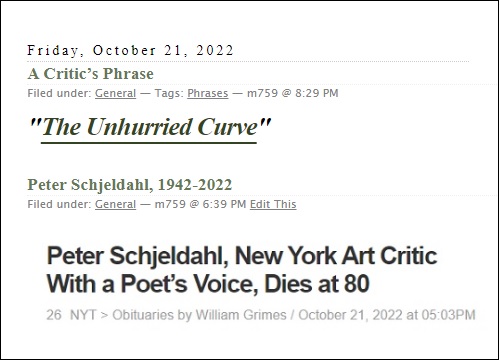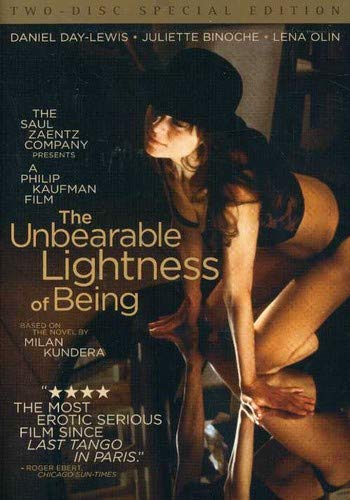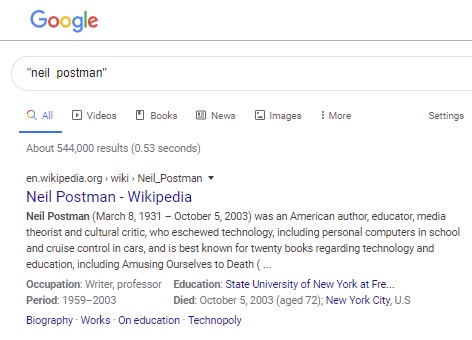Click image to enlarge.
Thursday, January 18, 2024
But Seriously: Mathematics for Davos
Sunday, December 10, 2023
Monday, May 1, 2023
But Seriously . . . From the E. Street School
Thursday, July 29, 2021
But Seriously, Bergen . . .
Monday, May 27, 2019
But Seriously . . .
I prefer the simple "four dots" figure
of the double colon:
For those who prefer stranger analogies . . .
Actors from "The Eiger Sanction" —
Doctor Strange on Mount Everest —

See as well this journal on the above Strange date, 2016/12/02,
in posts tagged Lumber Room.
Wednesday, January 23, 2019
But Seriously . . .
The previous post suggests a review.
Two images in memory of a journalist —
Illustration from a post on Monday, Jan. 21, 2019 (color inverted):
Friday, September 1, 2017
Wednesday, November 23, 2016
Saturday, July 23, 2016
But Seriously …
Those who want a serious approach to the mathematics
of Clifford algebras — via finite geometry, the natural setting
of the four-group of the previous post — should consult
"Finite Geometry, Dirac Groups and the Table of
Real Clifford Algebras," by Ron Shaw (1995).
Saturday, July 2, 2016
But Seriously …
British film director Robin Hardy reportedly
died yesterday. In his memory —
Hardy's film "The Wicker Tree" reportedly opened in the USA on
January 27, 2012. See also narratives in this journal on that date.
Thursday, May 12, 2016
But Seriously …
Google today released on GitHub an English parser,
Parsey McParseface . From Google Research Blog —
"Today, we are excited to share the fruits of our research
with the broader community by releasing SyntaxNet,
an open-source neural network framework implemented in
TensorFlow that provides a foundation for
Natural Language Understanding (NLU) systems.
Our release includes all the code needed to train new
SyntaxNet models on your own data, as well as
Parsey McParseface , an English parser that we have
trained for you and that you can use to analyze English text."
"While the accuracy is not perfect, it’s certainly high enough
to be useful in many applications. The major source of errors
at this point are examples such as the prepositional phrase
attachment ambiguity described above, which require real
world knowledge (e.g. that a street is not likely to be located
in a car) and deep contextual reasoning. Machine learning
(and in particular, neural networks) have made significant
progress in resolving these ambiguities. But our work is still
cut out for us: we would like to develop methods that can
learn world knowledge and enable equal understanding of
natural language across all languages and contexts."
But seriously …
For some historical background, see (for instance) a book by
Ekaterina Ovchinnikova —
Integration of World Knowledge for
Natural Language Understanding ,
Atlantis Press, Springer, 2012.
A PDF of Chapter 2, "Natural Language Understanding
and World Knowledge," is available for download.
The philosophical background is the distinction between
syntax and semantics . See (for instance) …
Saturday, September 6, 2014
But Seriously…
The previous post, Infinite Jest, suggests
a midrash on “–1/12” (i.e., minus one-twelfth):
Wednesday, February 12, 2014
But Seriously…
(A sequel to yesterday's Raiders of the Lost Music Box)
See, in this book, "Walsh Functions: A Digital Fourier Series,"
by Benjamin Jacoby (BYTE , September 1977). Some context:
Symmetry of Walsh Functions.
Tuesday, March 5, 2013
But Seriously…
Tuesday, January 22, 2013
But Seriously…
Introductory Aramaic
See also a theater review in yesterday's print NY Times
and a video in today's online Times:
Tuesday, September 4, 2012
But seriously…
This post is continued from May 12, 2011.
See also another journal's post on that date
as well as some related posts here.
Thursday, July 19, 2012
But Seriously…

For those who prefer fiction:
"Many Dimensions (1931) — An evil antiquarian illegally purchases
the fabled Stone of Suleiman (Williams uses this Muslim form
rather than the more familiar King Solomon) from its Islamic guardian
in Baghdad and returns to England to discover not only that the Stone
can multiply itself infinitely without diminishing the original, but that it
also allows its possessor to transcend the barriers of space and time."
— Wikipedia article on the author Charles Williams
Saturday, May 19, 2012
But Seriously…
Here is a link to a copy of the home page of a Turkish
author quoted here on May 4, 2012… in honor of
archaeologist Crawford Greenewalt Jr., who reportedly
died on that date. Greenewalt was an expert on the
ancient city of Sardis, in what is now western Turkey.
The May 4 quote was about
"Heraclitus’s Aion and His Transformations."
Saturday, April 21, 2012
But Seriously…
From Deadline Hollywood—
A film producer's death "between Friday night and early Saturday morning,"
April 13-14, 2012—
| R.I.P. Martin Poll
By THE DEADLINE TEAM | Sunday April 15, 2012 @ 7:36 pm PDT Veteran movie and TV producer Martin Poll died between Friday night and early Saturday morning of natural causes at a care facility on the Upper Westside in New York City. He was 89. |
See also the post linked to on the afternoon of Friday the 13th of April—
"All the saints have powers." — Cardinal Marchisano.
Happy birthday, James McAvoy (at left below in X-Men: First Class ).
Saturday, June 11, 2011
But Seriously–
"Mr. Messina is no ordinary Twitter user. The self-described
'hash godfather,' he officially invented the Twitter hashtag
in August 2007…."
— Ashley Parker (page ST1 of tomorrow's
NY Times National Edition)
But seriously—
Degreeless Noon—
Thursday, May 12, 2011
But Seriously…
Yesterday's "Succor" cited the New York Lottery of Tuesday— Midday 489, Evening 886.
One interpretation of these numbers—
- 489 as the number of a page in the Collected Poems of Wallace Stevens
with verses that suggested to one author the following questions:
"How can one express one's sense of the ground of things?
What is the structure of Being itself…?" — Thomas Jensen Hines - 886 as a number applied recently to a poem by Gerard Manley Hopkins
with the notable phrase "the unchanging register of change"
Some background from Tuesday—
- 489 background: See "Groups Acting" (10:10 AM EDT)
- 886 background: See a different Hopkins poem (linked to in "Rhyme Scheme," 1:23 AM EDT)
Sunday, November 21, 2010
But Seriously…
Friday, October 22, 2010
But Seriously…
Happy Birthday, Jean Simmons … Jan. 31, 2008
Elmer Gantry … Hollywood's view of the Foursquare Church
Resurrection … An August 2003 post inspired by KHYI, then broadcasting from Plano, Texas
For what it's worth, some free advice for Matt Damon…
GET QUOTES

Saturday, May 22, 2010
But seriously…
Lyche Gate

| Title | Ancient English ecclesiastical architecture and its principles, applied to the wants of the church at the present day American culture series II ; 029.008 |
| Author | Frank Wills |
| Publisher | Stanford and Swords, 1850 |
| Original from | the New York Public Library |
| Digitized | Apr 24, 2008 |
| Length | 120 pages |
| Subjects | Architecture, Medieval Church architecture |
Monday, March 15, 2010
But Seriously…
Kugelbild
"You are retracing your steps."
— Jacques Derrida

See also today's update (scroll down)
to Half-Circle Patterns as well as
Angels and Demons and Symbology.
Thursday, May 23, 2024
Logo Design: The Maltese Parrot

"The stuff that dreams are made of." — Bogart

But seriously . . .
|
From OSF . . . Among the positions that take this independence even further is Susanne Langer's approach towards meaning. Long before Derrida, she suggested in her chapter "The logic of signs and symbols" that we should understand meaning not as a relation to an author at all. Influenced by music and musical notation, she defines meaning instead as the function of a term from which a pattern emerges:
It is better, perhaps, to say: "Meaning is not a Reference: Langer, Susanne K., 1948 [1954]. Philosophy in a New Key: A Study in the Symbolism of Reason, Rite, and Art. Mentor Book. |
Thursday, February 29, 2024
Wednesday, October 26, 2022
The Hunt for Galois October
"… Évariste was born on October 25, 1811."
— Eric Temple Bell, Men of Mathematics
Related material —
But seriously . . .


Friday, March 18, 2022
Annals of Literary Analysis
On Doctor Strange in Spider-Man: No Way Home —
"This all-powerful wizard really used 'Scooby-Doo' as a verb
meaning 'successfully pull off a series of physical challenges
against monsters who are real.' What in the dad-trying-to-
relate-to-his-distant-son hell? That's like pumping someone up
to kick a game-winning field goal by saying 'Charlie Brown this crap.'"
— Vinnie Mancuso at Collider , November 17, 2021
But seriously . . .
From posts tagged Frankfurter —
"Scooby-Doo this ."
Friday, February 11, 2022
De Beer’s Consolidated Mine
The misleading image at right above is from the cover of
an edition of Charles Williams's classic 1931 novel
Many Dimensions published in 1993 by Wm. B. Eerdmans.
But seriously . . .
Monday, November 29, 2021
November 29 …
… is the birth date of storytellers C.S. Lewis and Madeleine L'Engle.
Another perspective on this date —

In the context of mathematics, I prefer to think of it as Brosterman Day.
See, from last year on this date, Osterman Meets Brosterman . . .
and, more generally, Brosterman.
But seriously . . . LAST THOUGHTS ON DEVIL'S NIGHT :
Thursday, September 30, 2021
Doctor Sleep — The Musical!
Sunday, September 5, 2021
Linguistics
A Letterman introduction for Plato's Academy Awards:
"Cunning, Anna. Anna, Cunning." (Rimshot.)
But seriously . . .
"This work [of Wierzbicka and colleagues] has led to
a set of highly concrete proposals about a hypothesized
irreducible core of all human languages. This universal core
is believed to have a fully ‘language-like’ character in the sense
that it consists of a lexicon of semantic primitives together with
a syntax governing how the primitives can be combined
(Goddard, 1998)." — Wikipedia, Semantic Primes
Goddard C. (1998) — Bad arguments against semantic primitives.
Theoretical Linguistics 24:129-156.
Related fiction . . . Lexicon , by Max Barry (2013). See Barry in this journal.
Thursday, September 3, 2020
LA Stories
Recreation of a 1960s LA marquee in “Once Upon a Time in Hollywood” —
But seriously . . .
See also a “Once-Upon-a-Time”-related death.
Sunday, March 29, 2020
Tuesday, February 4, 2020
Friday, May 13, 2016
For the Late Mark Lane
Sixties conspiracy theorist Mark Lane reportedly
died at 89 on Tuesday night.
From the previous post, But Seriously . . . —
"Today, we are excited to share the fruits of our research
with the broader community . . . ."

Tuesday, June 14, 2011
Plato’s Pheedo


But seriously—
Degreeless Noon—
Related material:
"Start the new year off with a new job at Pheedo."
Monday, June 6, 2011
Tree of Life — Jewish Version
Today's midday NY Lottery number was 753, the number of a significant page in Gravity's Rainbow .
An excerpt from that page ((Penguin Classics paperback, June 1, 1995)—

"… the Abyss had crept intolerably close, only an accident away…."
Midrash— See Ben Stein in this journal.
But seriously… See "Geometry and Death" in this journal.
See also PlanetMath.org on the Hesse configuration—

A picture of the Hesse configuration—
 .
.
Some context— A Study in Art Education.
Thursday, May 19, 2011
Bedrock
Today's previous post suggests the following—

Bester on bedrock and "the bottom line of all existence" suggests
a review of Wallace Stevens's "The Rock." Some background:
See Succor, May 11, and But Seriously, May 12.
See also Waiting for Benjamin, May 15.
Larry McMurtry famously wrote of reading Walter Benjamin
at the Dairy Queen. I never read Benjamin there, but I did
read at least some of the Bester book quoted above.
The bottom lines of this peculiar meditation—
It is not enough to cover the rock with leaves.
We must be cured of it by a cure of the ground
Or a cure of ourselves, that is equal to a cure
Of the ground, a cure beyond forgetfulness.
And yet the leaves, if they broke into bud,
If they broke into bloom, if they bore fruit,
And if we ate the incipient colorings
Of their fresh culls might be a cure of the ground.
— "The Rock," a poem by Wallace Stevens from
a section with the same title in the Collected Poems .
Thursday, May 6, 2010
Infinite Jest
Leg-Pulling
 |
"… to make the author manifestly unreliable"
Not to mention the reader.
Related material —
Wednesday, February 10, 2010
Mathematics and Religion, continued
But Seriously…
From "Georg Cantor and the Battle for Transfinite Set Theory," by Joseph W. Dauben (pdf)–

"It is easy, of course, to misinterpret the religious element in Cantor's thinking, as popularizers often do. This was certainly the case in an article that appeared not long ago in the French magazine La Recherche, which supplied [the above] caricatures to illustrate an expository article about Cantor, his religious convictions, psychological illness and transfinite set theory.* The first drawing depicts Cantor in ecstasy, as it were, receiving the divine message. In the second illustration, the figure with the gun of course is meant to be Kronecker– with God helping Cantor to maintain his balance– all of which rests precariously on a transfinite aleph. But there is a very serious side to all of this…."
* Pierre Thuillier, “Dieu, Cantor et l'Infini,” La Recherche, (December, 1977), pp. 1110-1116.
Everything and More: A Compact History of Infinity, by David Foster Wallace–
"In modern medical terms, it's fairly clear that G.F.L.P. Cantor suffered from manic-depressive illness at a time when nobody knew what this was, and that his polar cycles were aggravated by professional stresses and disappointments, of which Cantor had more than his share. Of course, this makes for less interesting flap copy than Genius Driven Mad by Attempts to Grapple with ∞. The truth, though, is that Cantor's work and its context are so totally interesting and beautiful that there's no need for breathless Prometheusizing of the poor guy's life. The real irony is that the view of ∞ as some forbidden zone or road to insanity– which view was very old and powerful and haunted math for 2000+ years– is precisely what Cantor's own work overturned. Saying that ∞ drove Cantor mad is sort of like mourning St. George's loss to the dragon: it's not only wrong but insulting."
Related entertainment:
David Foster Wallace,
Influential Writer, Dies at 46
and the film "Neverwas"–
Thursday, April 23, 2009
Thursday April 23, 2009
“Timothy J. Holst, who joined the Ringling Brothers and Barnum & Bailey Circus as a lowly Keystone Kops clown, rose to the role of singing ringmaster, and ultimately became the show’s talent czar, died April 16 in São Paulo, Brazil, during a visit to sign up circus acts. He was 61.”
Sunday, April 12, 2009
Sunday April 12, 2009
Is God, continued
Dialogue from the classic film Forbidden Planet—
"… Which makes it a gilt-edged priority that one of us gets into that Krell lab and takes that brain boost."
— Taken from a video (5:18-5:24 of 6:09) at David Lavery's weblog in the entry of Tuesday, April 7.
(Cf. this journal on that date.)
Thanks to Professor Lavery for his detailed notes on his viewing experiences.
My own viewing recently included, on the night of Good Friday, April 10, the spiritually significant film Indiana Jones and the Kingdom of the Crystal Skull.
The mystic circle of 13 aliens at the end of that film, together with Leslie Nielsen's Forbidden Planet remark quoted above, suggests the following:
|
"The aim of Conway’s game M13 is to get the hole at the top point and all counters in order 1,2,…,12 when moving clockwise along the circle." —Lieven Le Bruyn
The illustration is from the weblog entry by Lieven Le Bruyn quoted below. The colored circles represent 12 of the 13 projective points described below, the 13 radial strokes represent the 13 projective lines, and the straight lines in the picture, including those that form the circle, describe which projective points are incident with which projective lines. The dot at top represents the "hole."
From "The Mathieu Group M12 and Conway’s M13-Game" (pdf), senior honors thesis in mathematics by Jeremy L. Martin under the supervision of Professor Noam D. Elkies, Harvard University, April 1, 1996–
"Let P3 denote the projective plane of order 3. The standard construction of P3 is to remove the zero point from a three-dimensional vector space over the field F3 and then identify each point x with -x, obtaining a space with
Conway [3] proposed the following game…. Place twelve numbered counters on the points… of P3 and leave the thirteenth point… blank. (The empty point will be referred to throughout as the "hole.") Let the location of the hole be p; then a primitive move of the game consists of selecting one of the lines containing the hole, say There is an obvious characterization of a move as a permutation in S13, operating on the points of P3. By limiting our consideration to only those moves which return the hole to its starting point…. we obtain the Conway game group. This group, which we shall denote by GC, is a subgroup of the symmetric group S12 of permutations of the twelve points…, and the group operation of GC is concatenation of paths. Conway [3] stated, but did not prove explicitly, that GC is isomorphic to the Mathieu group M12. We shall subsequently verify this isomorphism. The set of all moves (including those not fixing the hole) is given the name M13 by Conway. It is important that M13 is not a group…." [3] John H. Conway, "Graphs and Groups and M13," Notes from New York Graph Theory Day XIV (1987), pp. 18–29. Another exposition (adapted to Martin's notation) by Lieven le Bruyn (see illustration above):
"Conway’s puzzle M13 involves the 13 points and 13 lines of P3. On all but one point numbered counters are placed holding the numbers 1,…,12 and a move involves interchanging one counter and the 'hole' (the unique point having no counter) and interchanging the counters on the two other points of the line determined by the first two points. In the picture [above] the lines are represented by dashes around the circle in between two counters and the points lying on this line are those that connect to the dash either via a direct line or directly via the circle. In the first part we saw that the group of all reachable positions in Conway's M13 puzzle having the hole at the top position contains the sporadic simple Mathieu group M12 as a subgroup." |
For the religious significance of the circle of 13 (and the "hole"), consider Arthur and the 12 knights of the round table, et cetera.

Sunday, February 19, 2006
Sunday February 19, 2006
But seriously…
(continued)
The Matrix:
Click on pictures for details.
In memory of George T. Davis,
who died on February 4,
a Hollywood ending:
“Santa Claus rides alone.”
— Clint Eastwood
Monday, November 7, 2005
Monday November 7, 2005
But seriously…
 “Sir Frederick Gray, Minister of Defence, is a dignified, upper-class gentleman who is well respected in intelligence circles. However for most of his appearances, Gray is a strict by-the-book person who plays it seriously at all times. Consequently he despises Bond’s playful attitude towards life and his disregard to take his missions seriously.”
“Sir Frederick Gray, Minister of Defence, is a dignified, upper-class gentleman who is well respected in intelligence circles. However for most of his appearances, Gray is a strict by-the-book person who plays it seriously at all times. Consequently he despises Bond’s playful attitude towards life and his disregard to take his missions seriously.”
Geoffrey Keen, who played Sir Frederick Gray in six James Bond films, died on November 3, 2005.
Related material:
The Log24 entry of 11:07 AM on the date of Keen’s death, and the five Log24 entries ending on January 20, 2005.
Wednesday, January 19, 2005
Wednesday January 19, 2005
But seriously…
A follow-up to the previous "tiger" entry (which was about an old but good dirty joke).
I just subscribed to The New York Review of Books online for another year, prompted by my desire to read Roger Shattuck on Rimbaud, a tiger of another sort:
"How did this poetic sensibility come to burn so bright?"
The Shattuck piece is from 1967, the year of The Doors' first album. (See Sunday's Death and the Spirit, Part II.)
Monday, May 26, 2003
Monday May 26, 2003
Mental Health Month, Day 26:
Many Dimensions,
Part II — The Blue Matrix
But seriously…
John Baez in July 1999:
"…it's really the fact that the Leech lattice is 24-dimensional that lets us compactify 26-dimensional spacetime in such a way as to get a bosonic string theory with the Monster group as symmetries."
Well, maybe. I certainly hope so. If the Leech lattice and the Monster group turn out to have some significance in theoretical physics, then my own work, which deals with symmetries of substructures of the Leech lattice and the Monster, might be viewed in a different light. Meanwhile, I take (cold) comfort from some writers who pursue the "story" theory of truth, as opposed to the "diamond" theory. See the following from my journal:
Evariste Galois and the Rock that Changed Things, and
A Time to Gather Stones Together: Readings for Yom Kippur.
See, too, this web page on Marion Zimmer Bradley's fictional
Matrices, or Blue Star-Stones, and

the purely mathematical site Diamond Theory, which deals with properties of the above "blue matrix" and its larger relatives.
Tuesday, August 6, 2002
Tuesday August 6, 2002
In honor of
Pope Callistus III, and
all of whom died on this date:
A lavender love butterfly vignette…
If you remember something there
That glided past you,
Followed close by heavy breathing,
Don't be concerned. It will not harm you;
It's only me, pursuing something
I'm not sure of.
and a
But seriously…
A few words in memory of a great mathematician, André Weil, who died on August 6, 1998:
"I wonder if it is because to-night my soul has really died that I feel at the moment something like peace. Or is it because right through hell there is a path, as Blake well knew, and though I may not take it, sometimes lately in dreams I have been able to see it?"
— Malcolm Lowry, 1947, Under the Volcano
There is a link on the Grand Finale site above to a site on British Columbia, which to Lowry symbolized heaven on earth. See also my website Shining Forth, the title of which is not unrelated to the August 6, 1993 encyclical of Pope John Paul II.






















































